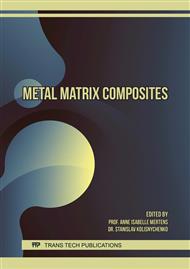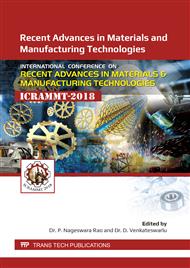[1]
Brendel, A., Popescu, C., Leyens, C., Woltersdorf, J., Pippel, E., & Bolt, H. (2004). SiC-fibre reinforced copper as heat sink material for fusion applications. Journal of Nuclear Materials, 329-333(1-3 PART A), 804-808.
DOI: 10.1016/j.jnucmat.2004.04.304
Google Scholar
[2]
Molina, A., Torres-Islas, A., Serna, S., Acosta-Flores, M., Rodriguez-Diaz, R. A., & Colin, J. (2015). Corrosion, electrical and mechanical performance of copper matrix composites produced by mechanical alloying and consolidation. International Journal of Electrochemical Science, 10(2), 1728-1741.
Google Scholar
[3]
Alaneme, K. K., & Odoni, B. U. (2016). Mechanical properties, wear and corrosion behavior of copper matrix composites reinforced with steel machining chips. Engineering Science and Technology, an International Journal, 19(3), 1593-1599.
DOI: 10.1016/j.jestch.2016.04.006
Google Scholar
[4]
Bai, H., Ma, N., Lang, J., Jin, Y., Zhu, C., & Ma, Y. (2013). Thermo-physical properties of boron carbide reinforced copper composites fabricated by electroless deposition process. Materials and Design, 46, 740-745.
DOI: 10.1016/j.matdes.2012.09.053
Google Scholar
[5]
R Radhakrishnan, Arunkumar K,. (2016), Corrosion and Hardness behavior of Copper Metal Matrix Composites, International Journal of Advanced Research in Management, Architecture, Technology and Engineering, Vol. 2, Special Issue 12.
Google Scholar
[6]
R.Venkatesh, S.Kumaraguru, Sunil Biswas, 2015, Preparation and Investigation of Cu-Co-Al2O3 Nanocrystalline Metal Matrix Composites, International Journal of Innovations in Engineering and Technology,Volume 5, Issue 3.
Google Scholar
[7]
Yener, T., Altinsoy, I., Yener, S. C., Celebi Efe, G. F., Ozbek, I., & Bindal, C. (2015). An evaluation of Cu-B4C composites manufactured by powder metallurgy. Acta Physica Polonica A, 127(4), 1045-1047.
DOI: 10.12693/aphyspola.127.1045
Google Scholar
[8]
Ragab, K., Abdel-Karim, R., Farag, S., El-Raghy, S. M., & Ahmed, H. A. (2010). Influence of SiC, SiO2 and graphite on corrosive wear of bronze composites subjected to acid rain. Tribology International, 43(3), 594-601.
DOI: 10.1016/j.triboint.2009.09.008
Google Scholar
[9]
Ram Kumar, S., Gowtham, S., & Radhika, N. (2018). Fabrication of cu-Sn/SiC metal matrix composites and investigation of its mechanical and dry sliding wear properties. Paper presented at the Materials Today: Proceedings, 5(5) 12757-12771.
DOI: 10.1016/j.matpr.2018.02.260
Google Scholar
[10]
Hong, E., Kaplin, B., You, T., Suh, M., Kim, Y. -., & Choe, H. (2011). Tribological properties of copper alloy-based composites reinforced with tungsten carbide particles. Wear, 270(9-10), 591-597.
DOI: 10.1016/j.wear.2011.01.015
Google Scholar
[11]
Radhika, N., Karthik, R., Gowtham, S., & Ramkumar, S. (2018). Synthesis of cu-10Sn/SiC metal matrix composites and experimental investigation of its adhesive wear behaviour. Silicon, 1-10.
DOI: 10.1007/s12633-018-9848-6
Google Scholar
[12]
Shankar, K. V., & Sellamuthu, R. (2016). An investigation on the effect of nickel content on the wear behaviour and mechanical properties of spinodal bronze alloy cast in metal mould. International Journal of Materials Engineering Innovation, 7(2), 89-103.
DOI: 10.1504/ijmatei.2016.10000389
Google Scholar
[13]
Shankar, K.V. and Sellamuthu, R A study on the effect of tin addition on mechanical and wear properties of spinodal alloys cast in metal mould, International Journal of Microstructure and Materials Properties, Vols. 10, Nos.5/6 (2015) pp.381-401.
DOI: 10.1504/ijmmp.2015.074994
Google Scholar
[14]
Shankar, K.V., Sellamuthu, R. Determination on the effect of tin content on microstructure, hardness, optimum aging temperature and aging time for spinodal bronze alloys cast in metal mold,, International Journal of Metalcasting, Volume 11, Issue 2, April 2017, Pages 189-194.
DOI: 10.1007/s40962-016-0034-6
Google Scholar
[15]
Archard J.F., 1953 Contact and rubbing of flat surfaces, Journal of applied physics, 24(8), 981-988.
DOI: 10.1063/1.1721448
Google Scholar
[16]
Shankar, K.V., Sellamuthu, R. Determination of optimum aging temperature and time, mechanical and wear properties for Cu-9Ni-6Sn spinodal bronze alloy cast using permanent mould,, International Journal of Materials Engineering Innovation, Volume 8, Issue 1, 2017, Pages 27-38.
DOI: 10.1504/ijmatei.2017.085809
Google Scholar



